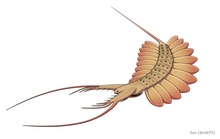Kerygmachela
| Kerygmachela Temporal range:
| |
|---|---|

| |
| Fossil of Kerygmachela kierkegaardi from the Sirius passet site | |

| |
| Reconstruction of Kerygmachela kierkegaardi based on later observations.[1] | |
| Scientific classification | |
| Domain: | Eukaryota |
| Kingdom: | Animalia |
| Phylum: | Arthropoda |
| Class: | †Dinocaridida |
| Family: | †Kerygmachelidae |
| Genus: | †Kerygmachela Budd, 1993 |
| Species: | †K. kierkegaardi
|
| Binomial name | |
| †Kerygmachela kierkegaardi Budd, 1993
| |
Kerygmachela kierkegaardi is a
Morphology

The head of Kerygmachela possesses a pair of well-developed frontal appendages which correspond to those of other dinocaridids and siberiid lobopodians.[4] Each of them terminates in a series of long spines. A pair of sessile, slit-like compound eyes is located slightly behind the base of these appendages.[1] A small anterior-facing mouth is located below the head and bears a pair of stylet-like structures.[1] The head also possesses a median lobe-like projection that carries a pair of small, possible ocular structures (median eye).[1] The body is composed of 11 segments, each indicated by 4 dorsal turberculates associated with 11 pairs of lateral flaps with dorsal gill-like wrinkling.[3] Initially, 11 pairs of small legs (lobopods) were thought to be evident just below the flaps,[3] but later observations suggest the lopobods were most likely absent, and the flaps were originated from ancestral lopobods instead.[5][2] The body ends with a single, stiff tail spine[1][2] that was formerly thought to be a pair of segmented cerci.[3][6]
Internally, Kerygmachela possesses a well-developed pharynx[1] and a midgut with 8 pairs of arthropod-like digestive glands.[7] The brain have ramified nerves extended to the median lobe, frontal appendages and eyes.[1] Only the protocerebrum (the frontal-most cerebral ganglion) was evident from the brain region, thus all of the other head nerves were considered protocerebral.[1] On the other hand, a subsequent study of radiodont Stanleycaris might suggest a deutocerebral origin for the frontal appendage nerves.[8]
Paleoecology
The spiny frontal appendages suggests that Kerygmachela may have been a predator; however, fossils indicate a total size of approximately 175 mm and, with a relatively small mouth, suggest that it would have been restricted to very small prey.
| Part of a series on |
| The Cambrian explosion |
|---|
 |
References
- ^ PMID 29523785.
- ^ ISSN 0022-3360.
- ^ a b c d e
Budd, Graham E. (1993), "A Cambrian gilled lobopod from Greenland", Nature, 364 (6439): 709–711, S2CID 4341971
- S2CID 7751936.
- ISSN 2056-2799.
- ^ Leanchoilia guts and the interpretation of three-dimensional structures in Burgess Shale-type fossils, Paleobiology
- PMID 24785191.
- ISSN 0960-9822.
Further reading
- Budd, G. E. (1999), "The morphology and phylogenetic significance of Kerygmachela kierkegaardi Budd (Buen Formation, Lower Cambrian, N Greenland)", Transactions of the Royal Society of Edinburgh, 89 (4): 249–290, S2CID 85645934
